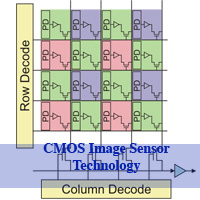Difference Between CCD and CMOS

There are only two types of image sensors that are being used in digital cameras, CCD chips and CMOS chips. The CCD or Charge Couple Devices contains an array of capacitors that gathers a charge that is proportional to the amount of light that is hitting it. The amount of charge in each capacitor is then converted into a numerical value by the cameras internal program to produce an image. CMOS or Complementary Metal Oxide Semiconductor is a name given to a group of integrated circuits that share a certain design. The CMOS image sensor is just one type of CMOS IC that has been built specifically for capturing images.
A CMOS image sensor captures light intensity via an array of photodetectors that are then coupled with an amplifier in order to attain a high enough to charge to quantify. Just like in CCDs, the data in each photodetector would then correspond to a pixel in the image output. The advantage of CMOS sensors over CCD is the cheap cost of producing them. This low cost of production would then easily translate to cheaper cameras. CMOS sensors also consume a considerably smaller amount of power compared to CCD sensors, giving CMOS cameras a longer usage duration before the battery runs out. That is why most cameras embedded in mobile phones and laptops have CMOS sensors in them.
But not all advantages belong to CMOS sensors, CCD sensors are more sensitive compared to former resulting in better images especially in low light conditions. CMOS sensors are also more susceptible to noise; this means that images captured by CCD sensors are cleaner or less grainy. For those reasons, most cameras and almost all of DSLR cameras employ CCD sensors. There is just no reason to sacrifice quality especially when doing professional photography. The CCD sensor is also a contributing factor to the high price of DSLR cameras since CCD sensors with very high resolutions are considerably pricier.
Each of these sensors has their own advantages and disadvantages that make them a perfect fit for a specific niche. CCDs are excellent for capturing high quality pictures that makes it perfect for professional photographers and hobbyists. CMOS cameras are cheaper and consume less power making it a good fit for multipurpose portable devices like mobile phones, PDAs, laptops, and gaming devices where image quality is not really a top priority. The gap between the two types of sensors has been narrowing as technology develops. It would only be a matter of time before it becomes hard to point out the advantages and disadvantages of each.
- Difference Between Sony Cybershot S Series and W Series - December 22, 2012
- Difference Between Samsung Galaxy S3 and iPhone 5 - December 21, 2012
- Difference Between Samsung Galaxy S2 (Galaxy S II) and Galaxy S 4G - December 20, 2012
Search DifferenceBetween.net :
 Email This Post
: If you like this article or our site. Please spread the word. Share it with your friends/family.
Email This Post
: If you like this article or our site. Please spread the word. Share it with your friends/family.
6 Comments
Trackbacks
- Difference Between Sony T77 and T700 | Difference Between | Sony T77 vs T700
- Difference Between CMOS and TTL | Difference Between | CMOS vs TTL


Everything I have says the CCD produces better quality pictures than the CMOS. Just why is it then the top of the range Sony camera, (a900) has a CMOS sensor?
read the last line:
“The gap between the two types of sensors has been narrowing as technology develops. It would only be a matter of time before it becomes hard to point out the advantages and disadvantages of each.”
As you will not be shooting flashless in super low light; moonlight for eg. you will atleast go for flash or longer shutter time. Plus in-camera post processing has come a long way.
i love these cam
sony Slt ALFA A35 as excellent picture clarity, and in 7(fps) frames per second .
In outdoor shooting and indoor shooting very good picture clarity.
I am using all SONY products only. this is user friendly.